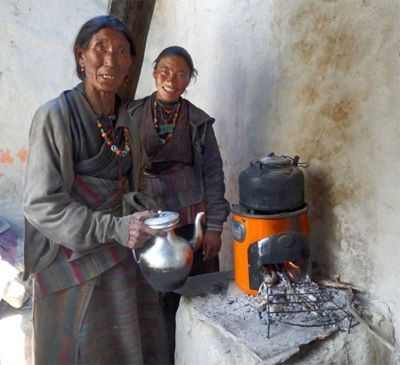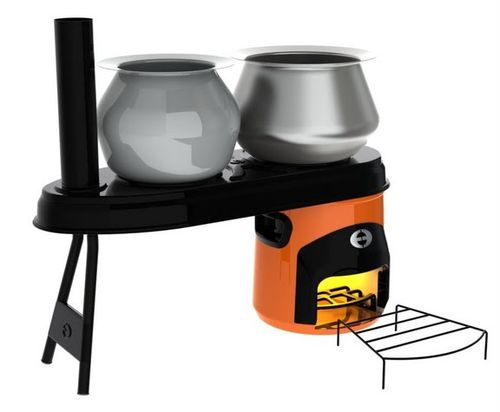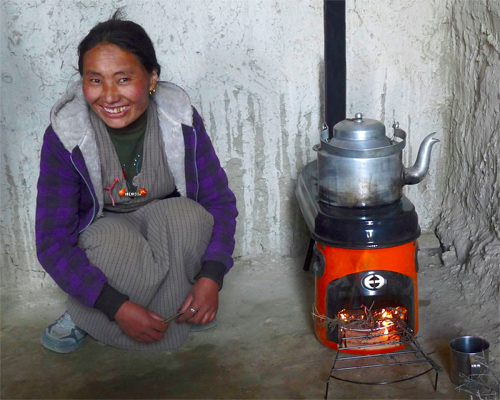“Free wood-burning stoves.” That’s the simple mission of the Himalayan Stove Project, a nonprofit founded in 2009 to provide people who now cook with rudimentary stoves or open-pit fires a cleaner-burning solution. After raising funds and getting logistics in line, this year the organization is set to deliver its first major shipment of 1,400 stoves. We caught up with founder George Basch last week. —Amy Oberbroeckling
GearJunkie: In a couple sentences, describe what your organization is all about.
George Basch: We are dedicated to improving the health of people in the trans-Himalayan region who now cook with traditional, rudimentary stoves or over open fires. We provide free, clean-burning, fuel-efficient cook stoves to individuals, families and communities.

You focus on human health and environmental issues with your stove. Explain.
Our stoves use wood but burn it more efficiently, so there is less smoke inside [when people are cooking]. Additionally, our stoves provide a chimney system so that the reduced smoke is vented outside the home. On the environmental side, our stoves still burn wood, dung, or crop waste, but they are much more efficient. They use only 20% of the fuel for the same cooking effect [compared to traditional methods]. Less fuel means less deforestation and less dung taken away from its primary role as a fertilizer and soil enrichment. Also, less fuel means less carbon emissions overall.
There are impoverished people all over the world. How did you come to choose those in the Himalayas?
I’ve had a life-long affair with the Himalayas since I was 13 years old and read Lowell Thomas Jr.‘s “Out of this world” book. I had made three trips to the region before starting the project. That allowed me to gain knowledge of the people, how they lived, and the environmental issues in the area.
Your main stove is called the Envirofit G-3300. Sounds high-tech!
The stoves are made by Envirofit International, a company out of Fort Collins, Colo. It took several years to perfect the design. The G-3300 model has no moving parts, just one replaceable ceramic piece. The stove still works even if that piece is gone. It’s easy to use, too, and very similar to traditional wood-burning stoves. You just light a fire and tend it.

The project was founded in 2009. Since then how many families have received stoves?
We had three-dozen pilot stoves delivered to Kathmandu in October of 2010 and they made it into homes in the region about a month later. The stoves received positive feedback so we decided to proceed and manufacture a modified design. The first of the final production stoves were delivered last spring. We’re just now finishing up the delivery of the first major distribution of 1,400 stoves.
The stoves are free to the family in the village?
We’ve established a philanthropic model when delivering stoves that requires most recipients to give back something to their community. What they pay is only a small fraction of the cost of the stoves. Stoves cost us about $125 to produce, and the people who receive them typically give back about the equivalent of $5 USD.
What are your goals for the next five years?
The need and demand for stoves is huge. By our rough calculations, there’s potential in the hundreds of thousands, perhaps even millions, of stoves in demand. We had originally set a goal of 10,000 stoves in five years. The challenge that we face is developing enough outside partnerships to do deliveries, installations, and to raise money. One shipping container holds 1,400 stoves, and each stove costs us about $125, so a container is $175,000 worth, which is a huge funding challenge.

How do you convince individuals to donate?
The people in the Himalayas are among the poorest in the world and the most vulnerable to the impact of polluted indoor air. Because of the harsh living conditions they face most of the year they don’t have a “cook outside” option that would work year-round.
How does your organization deliver the stoves to families?
We bring the stoves to Kathmandu by container and then arrange transport to the end of the road by truck, bus, plane, or whatever is needed. Area non-governmental organizations and the villagers use porters for the final delivery.
Thanks George, and good luck with your heroic effort!
—Amy Oberbroeckling is an assistant editor. Go to the Himalayan Stove Project website to learn more or donate to the cause.







